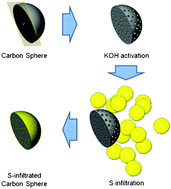Porous carbon spheres as a functional conducting framework for use in lithium–sulfur batteries†
Abstract
Porous carbon spheres with hybrid pore structure have been designed as a promising conducting framework to be used in cathode material for lithium–sulfur batteries. By creating three-dimensionally interconnected micropores and mesopores, sufficient space for sulfur storage, as well as electrolyte pathways, can be secured in the carbon spheres. Sulfur is mainly confined in mesopores with diameters of a few tens of nanometers in the carbon spheres and separated on the mesoscopic domain, which is advantageous for enhancing charge transfer and effectively accommodating volume expansion of sulfur during electrochemical reactions with Li+. The important role of the micropores, with diameters of less than 2 nm, is to extend effective interfacial contact between the sulfur and electrolyte, leading to enhancement of Li+ mobility. The sulfur-porous carbon sphere composite exhibits excellent cyclic performance and rate capability without significant capacity degradation caused by the loss of soluble Li polysulfides or electrical isolation of the active sulfur in the cathode. Importantly, the shape of the porous carbon spheres is advantageous for building robust electrodes with high-energy density. Our observations, based on various structural and electrochemical analyses, will be helpful for understanding and consolidating the fundamental aspects of the electrochemistry of sulfur. Furthermore, our approach is expected to be helpful in designing and tailoring advanced cathode materials with improved performance for lithium–sulfur batteries.


 Please wait while we load your content...
Please wait while we load your content...